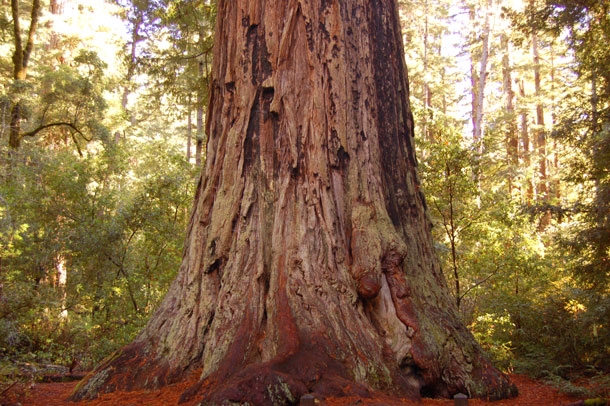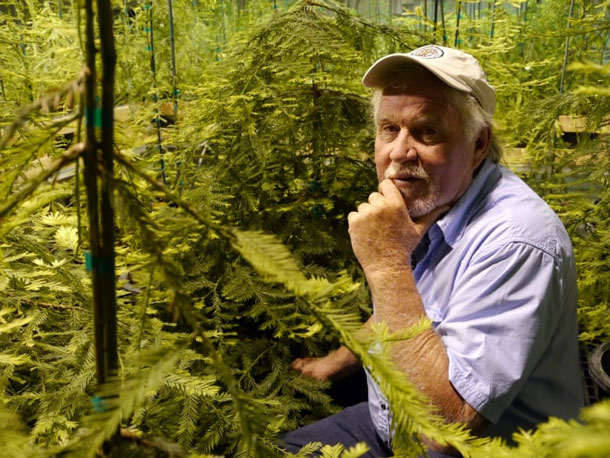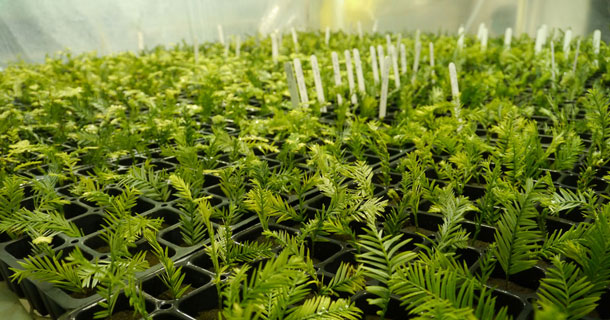Cloning Giant Sequoias
Air Date: Week of August 14, 2020

Photo of a Sequoia sempervirens trunk. (Photo: Flickr, CC BY-NC-ND 2.0)
The 3000-year-old Giant Sequoia and Coast Redwood trees of the Pacific Northwest are among the biggest and oldest individual living things on our planet. Sadly, all but a few were cut down for logs decades ago. To help restore these majestic trees which sequester large amounts of carbon, the non-profit organization Archangel Ancient Tree Archive has dedicated its efforts to cloning their DNA. David Milarch, co-founder of Archangel Ancient Tree Archive, tells host Bobby Bascomb why cloning specific trees can help restore a resilient population.
Transcript
BASCOMB: Around 3,000 years ago the Mayans were just getting started with their temples, Rome was still rural farmland, and it would be another 1000 years ‘til Jesus walked the earth. But also around 3000 years ago in the Pacific Northwest seeds fell and from them grew massive sequoia trees that are still alive today. Giant sequoias and other redwood trees are endemic to the Pacific Northwest and many were standing there long before white settlers came to the region. And when settlers did arrive they found trees more than 30 feet in diameter and hundreds of feet tall, perfect for lumber. Most have been cut down but now researchers have found a way to clone both the living giants as well as some ancient, seemingly dead, trees. Here to explain is David Milarch, co-founder of Archangel Ancient Tree Archive. David, welcome to Living on Earth.
MILARCH: Thanks for having me. It's an honor and a pleasure. It really is.
BASCOMB: So people may have seen old photos of redwood trees. You know, there are 30 or 40 people standing across one and over the top of them. But for someone who's never experienced a living redwood, can you describe redwood trees and what it's like to be in a grove of them?
MILARCH: Well, first and foremost, they're magical. They're enormous. And most people that we've taken to old growth redwood forests, the first thing that everyone has in common is they go completely silent. It's stuns you. They are so huge, up to 400 feet tall, 30 foot wide trunks. And then the next thing most people do is they walk up and they want to put their hand and touch the tree. And as soon as they put their hand up and touch the trees, then they go, wow, this is incredible.
BASCOMB: And what got you started with this project of cloning redwoods? What was the catalyst for that?
MILARCH: 25 years ago, the storm flags were flying on climate change, you know, we've known about climate change since the 60s. And I decided, we had two small children, we needed to find answers to reverse climate change. That's what started this project, finding the answers to reverse climate change.
BASCOMB: And how do redwoods play into that?
MILARCH: Redwoods sequester about 10 times the amount of CO2 that normal trees do. They grew up to 10 feet a year, they grow up to 3-4,000 years old, and they're working 24/7, sequestering CO2 and producing oxygen. And for, like, the Giant Sequoias that we've done, 40% of their dry weight is stored CO2.
BASCOMB: Wow.
MILARCH: So, they're about 1,000 tons apiece. So, 400 tons of that tree is stored excess CO2. That really adds up.
BASCOMB: And what are some of the other trees that you're looking at that are really good at sequestering carbon dioxide?
MILARCH: Giant Sequoia, the Cowrie trees down in New Zealand, Cottonwoods and Aspen's grow very quickly and they're one of our best hopes here in North America for sequestering CO2 on dry and arid land, some of the birches grow very, very quickly. So, it's usually the fastest growing, longest growing, healthiest trees that we're looking for that'll store the greatest amount of CO2. So that's a few.

Co-founder David Milarch of Archangel Ancient Trees Archive. (Photo: Courtesy of Archangel Ancient Tree Archive)
BASCOMB: From what I understand the first Redwood fossils date back to about 200 million years ago. But currently they're endangered or at least their populations are in demise. What happened with them? Is it just settlers coming along and cutting them down, or what happened with the redwoods?
MILARCH: It's real simple: man's greed. We have cut down 96% of our old growth redwood forest. For hot tubs, for lumber. And most of it went over across the Pacific. And there's vast quantities of it on the bottom of the ocean in the bays in China, getting ready to be utilized when the price goes up even more. So we've squandered it. We've cut them almost all down in the name of profit. That's before we even realized how great a promise they hold right now when climate change is just really starting to get going. So thank goodness, we decided to try and bring the old growth forests back. When we started 25 years ago, we were almost laughed off the face of the planet. You cannot clone 1,000 year-old, 2,000 year old-trees that we were told. It's like a 115 year old woman trying to have a child. It won't work. We've tried. You're wasting your time. Go back home. That's what we heard from most academics and most forest service people. So we blundered on and we broke through. And I'm happy to say we have cloned 130 different species of trees, all champion trees, the largest and oldest of their species.
BASCOMB: So how do you make a clone of a 3,000 year old Redwood tree?
MILARCH: Well let's begin here. Almost every tree on the planet is self-cloning. What we're doing is just hurrying up the process. We're not changing the DNA at all, we're not doing anything other than nature would do itself. But how we do that is we send climbers to the very tops of these trees, and out to the very ends of the branches. And we found that if we gather this year's new growth, the hormones and chemicals that go through these trees that don't allow them to be cloned haven't gotten there yet. So our climbers bring them down, we rush to a FedEx or somewhere where we can overnight them back to Copemish, Michigan, to our lab. And the very next day we start to work our magic on them, and we're asking them to form roots or to self-clone.
BASCOMB: So the cut down redwoods are they also sending out shoots?
MILARCH: Yes, those are called basal sprouts. But that's a whole different story. One of the trees we worked on were the Coast Redwoods. The coast redwoods have a 500 mile native range from the Oregon-California border, south, down to Big Sur. That's the only range of Coast Redwoods on the planet. Well, we drove and walked that entire 500 mile range. But something different. We look for redwoods, Coast Redwoods on private property.
BASCOMB: Why?
MILARCH: Because the little remnant forests here and there the Coast Redwoods that were saved. When we asked to try to be able to clone those on state and federal land, they said no. So we said. Well, all right, we'll look on a private land. And thank goodness we did. Because the biggest Coast Redwoods and the biggest giant Sequoias are not on state and federal property. They're on private property. One day, my son, Jake Milarch, and I, and Michael Taylor. We were searching for Coast Redwoods and we happened upon a valley. And in this valley behind some people's homes, we found enormous stumps.Trees that were 30 to 35 foot in diameter. Across the top of the stump, a very, very large Coast Redwood was a 20 foot diameter Coast Redwood here we found Coast Redwoods that we're 10 feet or so bigger in diameter than General Sherman, the largest tree on Earth. These were cut down in 1870, and lost. Nobody knew they were there, we stumbled across them. So after I got my composure, and my son walked up to the 35 foot diameter stump, he said, hey, Dad, we should try and clone these. I said, well, Jake, we're pretty good, but these have been cut down for 100 years. He goes, yep, but there's still life in 'em. Let's try.

Sequoia sempervirens seedlings post cloning methods. (Photo: Courtesy of Archangel Ancient Tree Archive)
BASCOMB: So how do you make a clone of a dead tree, though? I mean, there's some life in it, he said. But where does that life come from?
MILARCH: Well, the beauty of redwoods is that they almost refuse to die. You can't burn them down. They withstand stand fire. Disease hardly ever attacks them. You can dynamite them, you can cut them down, but they'll cling to life and they know that on their way out, the mother tree, when she is attacked, and it's life threatening, she'll send up what's called basal sprouts. So out of her trunk, or out of the root system, she'll send up basal sprouts and she'll self clone herself. So we found the basal sprouts, my son did, we took living tissue of that, sent it back to the lab. And I'm happy to say that we have found five different stumps, 30 feet in diameter, across the top, and larger that we've now made thousands of clones. Those trees live on now in seven countries.
BASCOMB: Now, how old are those trees? If they're that much bigger than the other trees, you're saying, how old are they? And and if you could maybe put that into context. I mean, what was happening in the world when these trees were just sprouting and getting going in life?
MILARCH: Well, the trees of 30 foot diameter the Coast Redwoods was we figured to be 2,500 years old. So when Jesus walked the earth, they're already 500 years old. The giant Sequoias is that we found in the Lost Grove, on the very top of the Sierra Nevada Mountains, they are between 3-4000 years old.
BASCOMB: What are the advantages of cloning these ancient trees as opposed to just growing them from seed?
MILARCH: Most Coast Redwoods don't live to be 1000 years old. The ones we're cloning are 2000, 3000 years old. And nobody knows how they were able to do that. Their DNA has never been studied, but doesn't it make sense to us the biggest, oldest, strongest trees that live two or three times the normal age of their species to put those genetics back into our forests?
BASCOMB: What is the future for your work? I understand that you're working in other countries and you have high aspirations but what are you your goals here?
MILARCH: We plan on working in New Zealand this coming year, and Australia. They're just screaming down there for our trees and for us to come down and help preserve their trees. So we're going to do a fundraiser to get down to New Zealand and do the Cowrie Trees. And Australia has pledged to plant a billion trees, they like to plan a bunch of their native clones, so. And, God willing, the funding will come in and we'll be able to go out around the world this year as we planned and teach a lot of the children and get a lot of this work done.
BASCOMB: What motivates you to do this work?
MILARCH: Going after workable, doable solutions to reverse climate change. I don't want to leave this planet and leave my children and my grandchildren, or the world's children and grandchildren, to have to to go through the nightmares that the scientists are predicting. I can't do that. So as long as I draw breath, I will do everything in my power to avert this so everyone's grandchildren don't have the future that some are looking at. We can do better.
BASCOMB: David Milarch is Co-founder of Archangel Ancient Tree Archive. David, thank you so much for sharing your story with me.
MILARCH: Thanks for having me.
Links
Archangel Tree Archive Website
Washington Post | “Decoding the Redwoods”
Huffington Post | “Redwood Trees May Help Battle Climate Change, Study Finds”
Living on Earth wants to hear from you!
Living on Earth
62 Calef Highway, Suite 212
Lee, NH 03861
Telephone: 617-287-4121
E-mail: comments@loe.org
Newsletter [Click here]
Donate to Living on Earth!
Living on Earth is an independent media program and relies entirely on contributions from listeners and institutions supporting public service. Please donate now to preserve an independent environmental voice.
NewsletterLiving on Earth offers a weekly delivery of the show's rundown to your mailbox. Sign up for our newsletter today!
 Sailors For The Sea: Be the change you want to sea.
Sailors For The Sea: Be the change you want to sea.
 The Grantham Foundation for the Protection of the Environment: Committed to protecting and improving the health of the global environment.
The Grantham Foundation for the Protection of the Environment: Committed to protecting and improving the health of the global environment.
 Contribute to Living on Earth and receive, as our gift to you, an archival print of one of Mark Seth Lender's extraordinary wildlife photographs. Follow the link to see Mark's current collection of photographs.
Contribute to Living on Earth and receive, as our gift to you, an archival print of one of Mark Seth Lender's extraordinary wildlife photographs. Follow the link to see Mark's current collection of photographs.
 Buy a signed copy of Mark Seth Lender's book Smeagull the Seagull & support Living on Earth
Buy a signed copy of Mark Seth Lender's book Smeagull the Seagull & support Living on Earth

